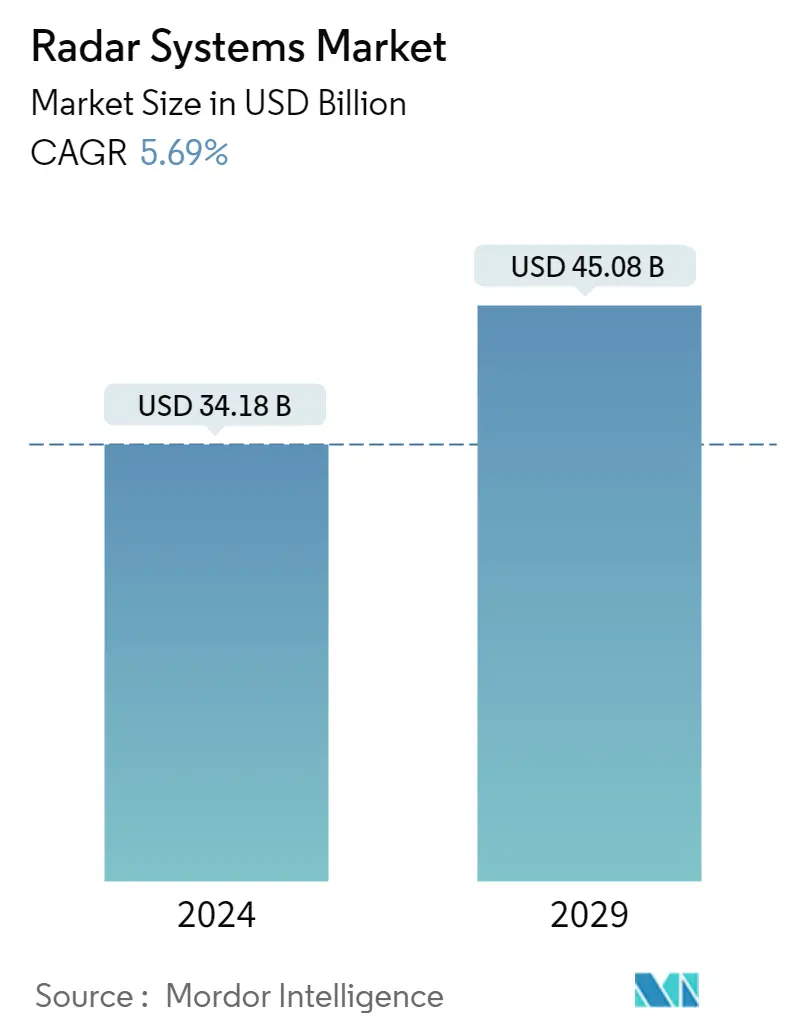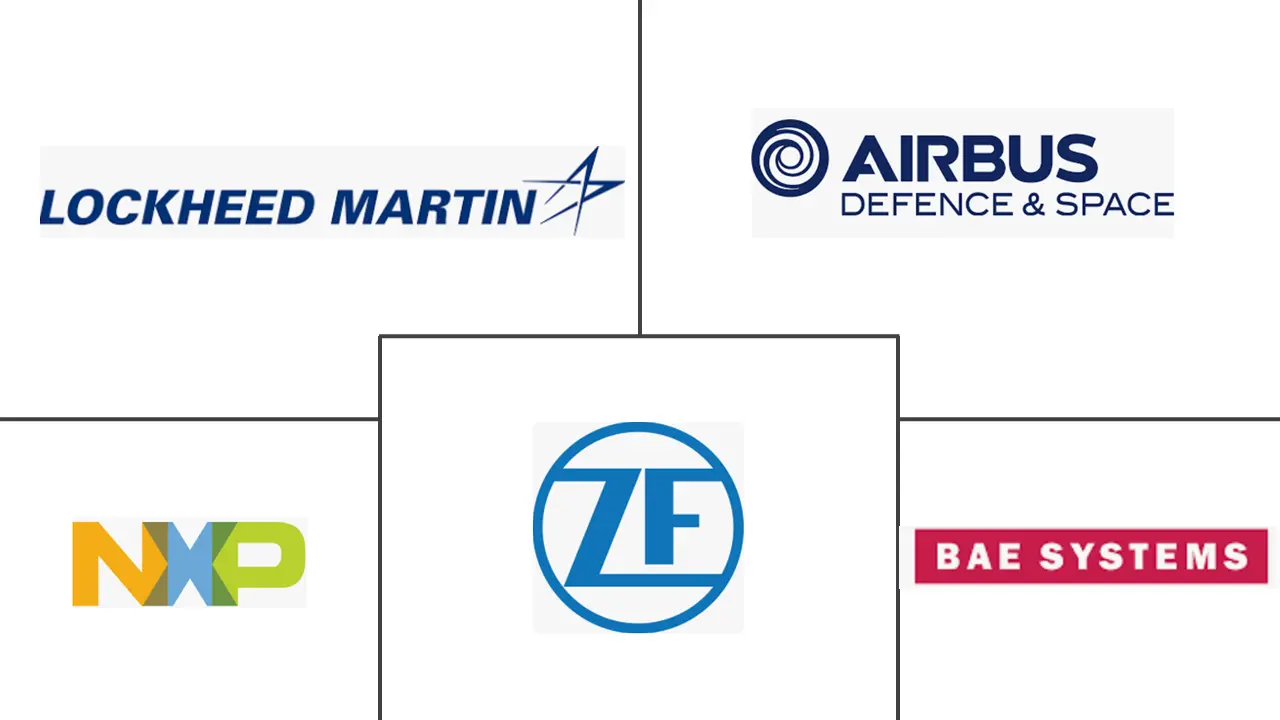Market Size of Radar Systems Industry

| Study Period | 2019 - 2029 |
| Market Size (2024) | USD 34.18 Billion |
| Market Size (2029) | USD 45.08 Billion |
| CAGR (2024 - 2029) | 5.69 % |
| Fastest Growing Market | North America |
| Largest Market | North America |
| Market Concentration | High |
Major Players
*Disclaimer: Major Players sorted in no particular order |
Radar Systems Market Analysis
The Radar Systems Market size is estimated at USD 34.18 billion in 2024, and is expected to reach USD 45.08 billion by 2029, growing at a CAGR of 5.69% during the forecast period (2024-2029).
Radars can be used in meteorology, aerial surveillance, and maritime domains. Radars in automobiles can help measure the speed of cars on the road. Companies are using AI technologies to develop different types of radars for various industrial applications. A significant technological advancement is laser radar, which is ideal for usage in the automotive sector.
- The worldwide spending on military and defense services has increased over the years, and countries are investing in AI-supportive technologies for security to keep their country and border safe from intruders. Japan's Self-Defense Forces deployed SPY-7 radar, developed by Lockheed Martin. When connected to the Aegis Weapon System for Japan, this radar will aid in identifying, tracking, and discriminating ballistic missile threats and successfully targeting interceptors.
- Automobile companies are investing heavily in autonomous driving solutions, the major factor behind the rising demand for automotive hardware products like domain control units, cameras, radar, safety sensors, and more. Hyundai introduced a radar-based rear occupant alert system for passenger convenience and safety at the highest level of autonomous driving. The system can detect even the slightest movement of a passenger and is composed of a radar sensor module concealed in the ceiling, CAN, and the Integrated Body-control Unit (IBU).
- The COVID-19 pandemic squeezed the world economy by affecting the manufacturing industry, production, disruption, and financial systems. Many countries reduced their budget for their defense services to overcome inflation, which affected the demand for radar systems as military services are the primary users of this application. The international trade of radar systems was also affected as companies held back their funds for non-essential collaboration.
- It is important to study the architecture of the products where the radar is being plugged for further use, as radar is often used with other sensing technologies, such as video cameras and LiDAR. Automobile radars must function in various urban, rural, and inter-state contexts. This wide range of velocities challenges the waveform design, chirp configuration, and frame size, impacting the radar functioning.
Radar Systems Industry Segmentation
The term RADAR stands for Radio Detection and Ranging. Radio waves are the foundation of radar. In a similar way to wireless computer networks and mobile phones, radars emit electromagnetic waves. It has the property to detect surrounding objects using radio waves. Radars can be used in meteorology, aerial surveillance and even the maritime domain. Radars can be used to measure the speed of cars on the road.
The radar systems market is segmented by type, application, end-user industry, and geography. By yype, the market is segmented into continuous wave RADAR Systems and pulsated wave RADAR systems). By application, the market is segmented into airborne, land-based, and naval. By end-user industry, the market is segmented into aviation, maritime applications, automotive, military and defense. The report also covers the market sizes and forecasts for the radar systems market in major countries across different regions. For each segment, the market size is provided in terms of value (USD).
| By Type | |
| Continuous Wave RADAR Systems | |
| Pulsated Wave RADAR Systems |
| By Application | |
| Airborne | |
| Land-based | |
| Naval |
| By End-user Industry | |
| Aviation | |
| Maritime Applications | |
| Automotive | |
| Military & Defense |
| Geography | ||||||
| ||||||
| ||||||
| ||||||
|
Radar Systems Market Size Summary
The radar systems market is poised for significant growth, driven by advancements in technology and increasing applications across various sectors. The integration of artificial intelligence in radar development is enhancing capabilities in fields such as meteorology, aerial surveillance, and maritime security. In the automotive industry, the adoption of radar systems is crucial for the advancement of autonomous driving technologies, with companies like Hyundai and Volkswagen investing heavily in these solutions. The market is also witnessing the emergence of laser radar technology, particularly beneficial for automotive applications. Despite challenges posed by the COVID-19 pandemic, which affected defense budgets and international trade, the market is recovering as countries prioritize security and defense investments. The demand for radar systems is further bolstered by the need for advanced driver-assistance systems (ADAS) and the growing trend towards IoT and smart vehicles.
The defense sector remains a significant contributor to the radar systems market, with countries like the United States and Canada investing in advanced radar technologies for national security. The market is characterized by consolidation, with major players such as Airbus SE and BAE Systems plc dominating the landscape. However, new entrants like Infineon Technologies AG and NXP Semiconductors N.V. are capitalizing on opportunities in the automotive radar segment. Innovations such as Uhnder's 4D digital imaging radar and Mobileye's software-defined imaging radars are setting new standards for precision and interoperability. These developments are expected to enhance the safety and reliability of autonomous vehicles, further driving market growth. As the market evolves, collaborations and technological advancements will continue to shape the future of radar systems across various industries.
Radar Systems Market Size - Table of Contents
-
1. MARKET DYNAMICS
-
1.1 Market Overview
-
1.2 Technology Snapshot
-
1.3 Market Drivers
-
1.4 Market Restraints
-
1.5 Industry Attractiveness - Porter's Five Forces Analysis
-
1.5.1 Threat of New Entrants
-
1.5.2 Bargaining Power of Buyers/Consumers
-
1.5.3 Bargaining Power of Suppliers
-
1.5.4 Threat of Substitute Products
-
1.5.5 Intensity of Competitive Rivalry
-
-
-
2. MARKET SEGMENTATION
-
2.1 By Type
-
2.1.1 Continuous Wave RADAR Systems
-
2.1.2 Pulsated Wave RADAR Systems
-
-
2.2 By Application
-
2.2.1 Airborne
-
2.2.2 Land-based
-
2.2.3 Naval
-
-
2.3 By End-user Industry
-
2.3.1 Aviation
-
2.3.2 Maritime Applications
-
2.3.3 Automotive
-
2.3.4 Military & Defense
-
-
2.4 Geography
-
2.4.1 North America
-
2.4.1.1 United States
-
2.4.1.2 Canada
-
-
2.4.2 Europe
-
2.4.2.1 United Kingdom
-
2.4.2.2 Germany
-
2.4.2.3 France
-
2.4.2.4 Rest of Europe
-
-
2.4.3 Asia-Pacific
-
2.4.3.1 China
-
2.4.3.2 Japan
-
2.4.3.3 India
-
2.4.3.4 Rest of Asia-Pacific
-
-
2.4.4 Rest of the World
-
2.4.4.1 Latin America
-
2.4.4.2 Middle East and Africa
-
-
-
Radar Systems Market Size FAQs
How big is the Radar Systems Market?
The Radar Systems Market size is expected to reach USD 34.18 billion in 2024 and grow at a CAGR of 5.69% to reach USD 45.08 billion by 2029.
What is the current Radar Systems Market size?
In 2024, the Radar Systems Market size is expected to reach USD 34.18 billion.

